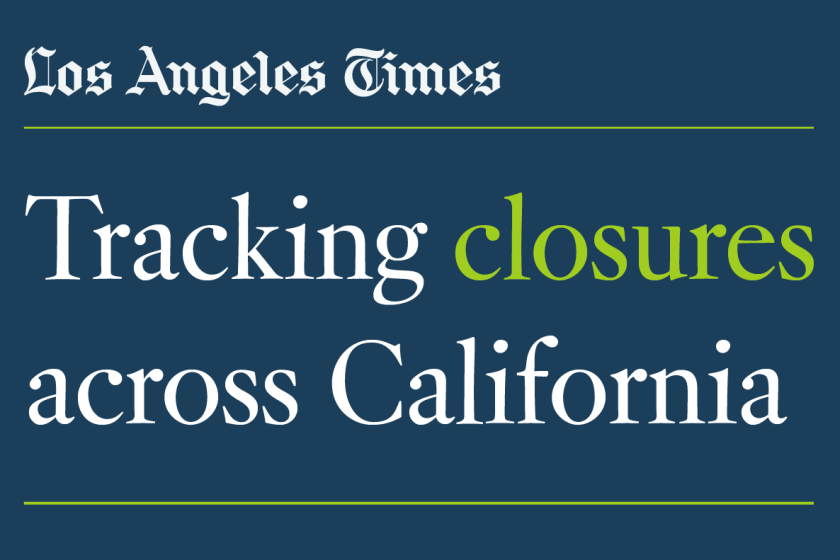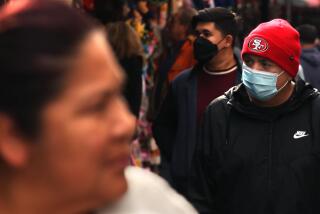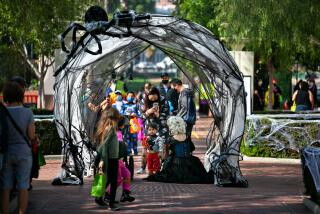California has escaped the national surge in coronavirus cases. But new dangers lie ahead
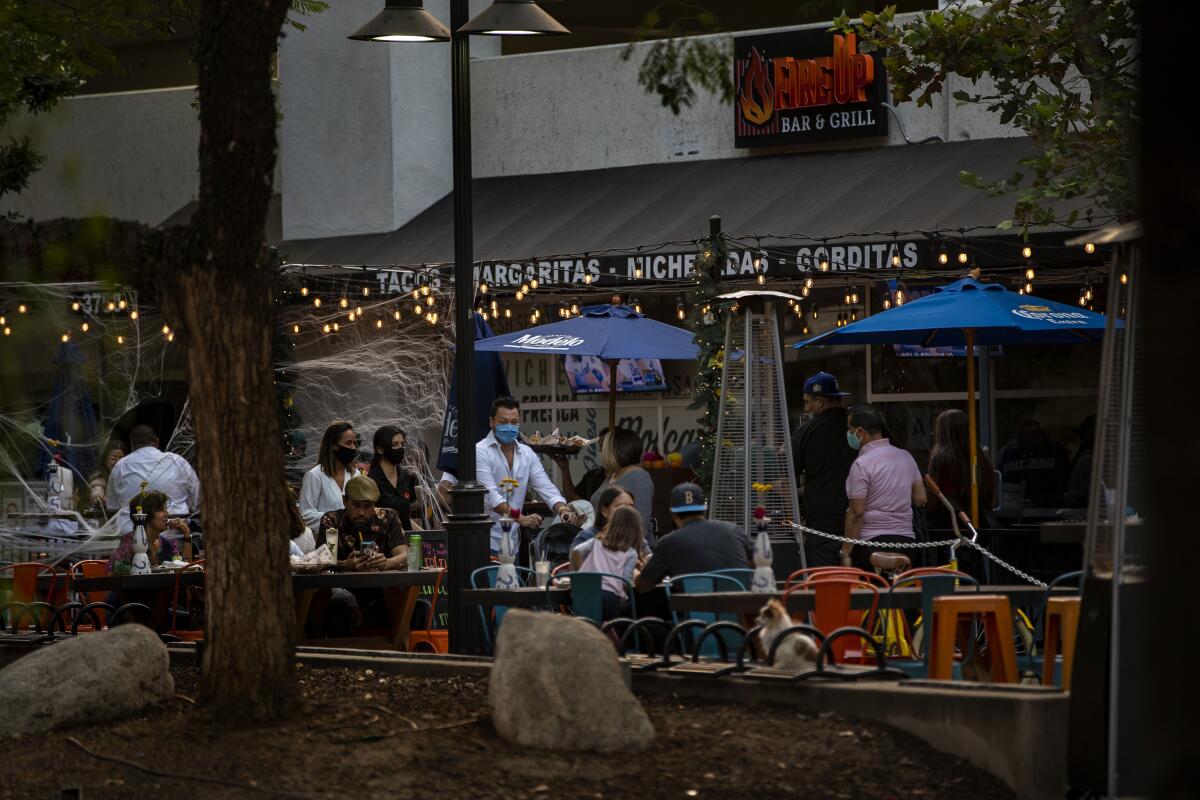
SAN FRANCISCO — California has largely avoided a new wave of coronavirus cases that has sparked alarm elsewhere in the country, but the state faces new dangers in the coming weeks as key businesses reopen and the holidays arrive.
In what health experts describe as a significant achievement, California over the last two months has managed to reopen key parts of the economy without seeing the widespread spike in cases, hospitalizations and deaths that occurred this summer.
They credit Gov. Gavin Newsom’s overhauled system — introduced Aug. 28 and much tougher than the state’s disastrous first reopening — as a big reason for California having so far staved off a new surge in cases.
Moreover, the state has been sticking to the rules, a change from the more haphazard approach taken in the spring. For example, Riverside and Shasta counties on Tuesday were pushed into the most restrictive tier, or the purple category — requiring gyms and places of worship to operate outdoors and restaurants to close indoor dining rooms — as cases began to rise again.
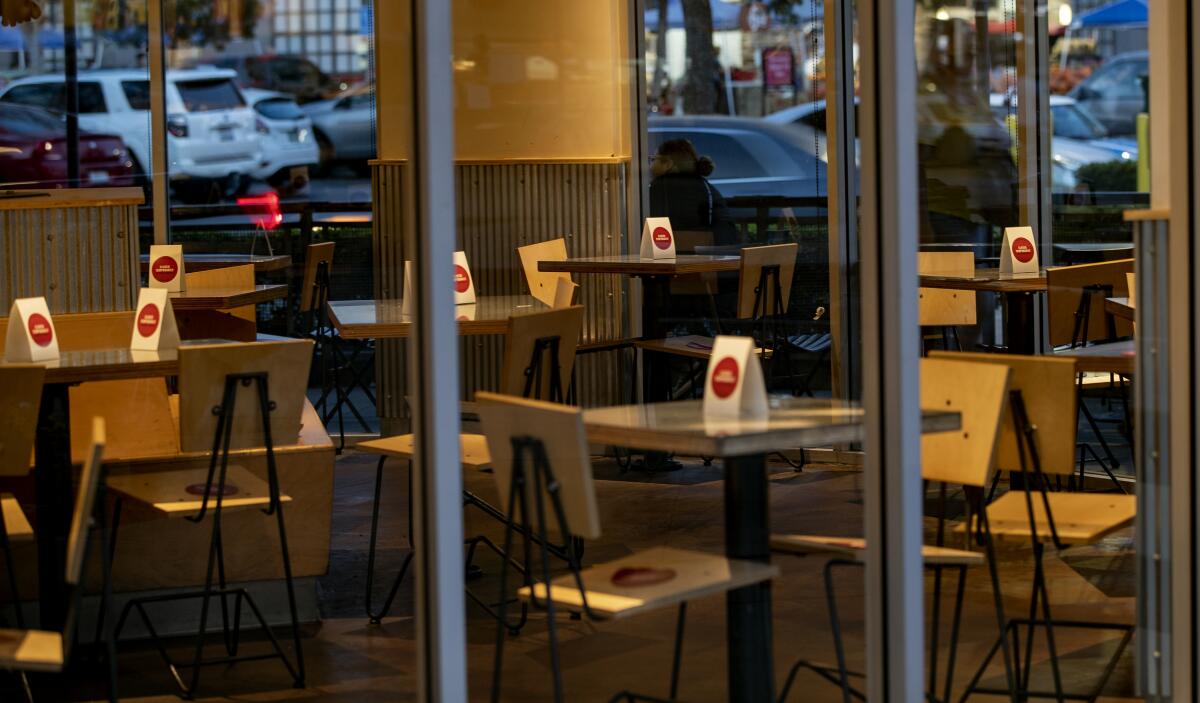
New threats are looming. Officials are worried that Halloween, Thanksgiving and Christmas could encourage super-spreader events if people, fatigued by months of isolation, decide to start socializing again without proper precautions, which is what caused so many problems in the summer. More than 17,000 Californians have died from COVID-19, and the summer was the state’s deadliest season.
A third wave may come down to whether Californians can continue to make the sacrifice of isolation over tradition as the holidays roll around.
“This is the year, unfortunately, to stay with those loved ones that you have been sheltering with up to now, to stay within your smaller, intimate bubble and to have a low-key Thanksgiving and winter holidays,” said Dr. Kirsten Bibbins-Domingo, chair of UC San Francisco’s Department of Epidemiology and Biostatistics. “The challenge of understanding viral transmission is the exponential rate that it grows. So when things are low, if we are not vigilant, they can go high very quickly.”
For the moment, California remains a standout in a nation still struggling to contain the virus.
“We have no sign yet — yet — of a third wave,” said Dr. George Rutherford, epidemiologist and infectious diseases expert at UC San Francisco.
By contrast, “it’s gone so wrong in the rest of the country. There’s a clear third wave [nationally]. The cases have doubled since early September,” Rutherford said. “The rest of the country is doing a lot of stuff wrong.”
The reasons are not surprising: Apart from California, Hawaii, New England and the Mid-Atlantic, “they’re not wearing masks nearly as much as they should. ... They’ve reopened very quickly, so that Florida, for instance, has basically no controls on at all. And predictably, they’re seeing big surges of disease,” Rutherford said.
Dr. Mark Ghaly, secretary of the California Health and Human Services Agency, said state officials built a “slow and stringent” approach based on what they learned from the first reopening. “We have worked hard across the state … taking the lessons from earlier parts of our response and changing them,” he said.
Hospitalizations rose in 39 states over the last week — and California was not among them, according to the COVID Tracking Project. California has seen its coronavirus hospitalizations fall for 12 consecutive weeks, according to a Los Angeles Times analysis.
For the seven-day period that ended Sunday, there were an average of 2,243 people with confirmed coronavirus infections daily in California’s hospitals, a number not seen since early April.
“We have hit a very good approach with this tiered system of what activities are allowed,” said Dr. Robert Kim-Farley, medical epidemiologist and infectious diseases expert at the UCLA Fielding School of Public Health.
California’s decision to keep some of the highest-risk businesses closed may be one of the reasons why the state is doing better than others across the U.S.
California has continued to keep potential hot-spot venues like nightclubs, convention centers, concert arenas and live theaters shuttered. Indoor bars that don’t offer meals have been ordered shut in most of the state.

Theme parks have also stayed closed; on Tuesday, California issued strict new rules on how they can reopen, but they’re so tough that the largest parks may remain shut for many more months until disease levels further drop to the least-restrictive tier — or the yellow category. The rules prompted strenuous objections from executives at theme parks like Disneyland.
Theme parks are potential areas of viral transmission, as the Disneyland measles outbreak of late 2014 and early 2015 demonstrated, linked to infections traced later to seven U.S. states, Mexico and Canada.
California this week also offered criteria for how counties can allow stadiums to reopen to spectators. Outdoor arenas can reopen to spectators of professional sports events in counties in the second-least restrictive tier — the orange category — with capacity capped at 20%. Ticket sales must be limited to customers traveling 120 miles or less.
Those changes came with controversy. The county executive for Santa Clara County, Dr. Jeffrey Smith, called the state’s changes “really quite dangerous.” Santa Clara County plans to stick with a stricter approach and not allow fans at professional sports events anytime soon, including the home stadium of the San Francisco 49ers.
Smith warned the relaxed rules would still allow about 14,000 people at Levi’s Stadium — hundreds of whom could be infected, he calculated, easily causing a super-spreader event. “At a time period when California is beginning to see some light, this amounts to another step backwards,” Smith warned.
State officials this week also allowed every county to permit the reopening of tattoo parlors, piercing shops, massage therapy shops and other personal-care service businesses regardless of the county’s tier status.
Newsom’s tiered reopening approach allows counties to reopen gradually after meeting certain criteria, such as coronavirus case rates, positive test rates and minimizing disproportionately worse pandemic impacts in disadvantaged neighborhoods. There are four tiers — purple, red, orange and yellow — with each allowing more types of businesses to reopen or at a greater capacity.
To contain the spread of COVID-19, parks, restaurants and stores are slowly reopening.
Also helping California’s efforts in the pandemic has been the fading controversy of the state’s mandatory mask rule.
Orange County was once a hotbed of dissent over mask requirements. But more recently, county leaders have been consistent in urging people to wear masks, saying doing so only helps schools and businesses reopen more quickly.
Dr. Shruti Gohil, associate medical director of epidemiology and infection prevention at UC Irvine, said she’s noticed at her local school in Orange County, where classrooms have reopened, there was initially lots of discussion about not wanting to make masks mandatory for schoolchildren.
But masking seems to be more widely accepted now. “The teachers, for example, say: ‘Boy, the kids just did great. They just came in and wore their masks all day long,’ ” Gohil said. “That shift in the culture, it takes time.”
This week marked the entry of California’s first urban county into the state’s least restrictive tier: San Francisco. In the past seven days, San Francisco has recorded just 28 new cases per 100,000 residents; L.A. County reported 63 cases per 100,000 residents, according to The Times’ tracker.
Now in the yellow tier, San Francisco officials said that in the coming weeks there are plans to allow nonessential offices to reopen at reduced capacity and allow the reopenings of indoor pools and bowling alleys. High schools are on track to allow in-person learning in November. The city also plans to increase the capacity of indoor dining rooms and places of worship from 25% to 50%.
Los Angeles County remains in the state’s worst tier, with coronavirus transmission still deemed widespread.
Barbara Ferrer, the county’s public health director, said there seems to be improvement in controlling the disease at work sites. But the pandemic continues to spread at celebrations and gatherings both large and small.
“There are still people who don’t feel like they need to take precautions,” Ferrer said. “And I also think there is a false sense of security we have when we’re with people we know,” she said, leading people to take their masks off, thinking that everyone at an event is free of disease.
“And time and time and time again, that is not accurate, and oftentimes has a devastating consequence,” Ferrer said.
State officials announced they will devote more resources to Los Angeles, Riverside and San Bernardino counties, such as increasing mobile testing and helping those infected to isolate themselves while they recover. San Diego County, currently in the second-most restrictive tier, is at risk of falling back into the most restrictive tier.
There’s also increasing evidence of the growing disproportionate impact the pandemic has had on people of color — both from the disease and economically — and experts say it’s essential that help arrives in areas of great need.
A recent UC San Francisco study found the number of Spanish-speaking Latino families in the Bay Area who cannot afford to eat balanced meals and go to bed hungry has more than doubled. And in Fresno, a survey of registered voters conducted by the UC Merced Community and Labor Center and community groups found that more than half of Latino, Black and Asian American households suffered from lost jobs or reduced work hours because of the pandemic, according to the center’s director, Ana Padilla.
Statewide, Latino, Black, Native Hawaiian and Pacific Islander residents are dying at disproportionately higher levels from COVID-19.
California must remain concerned about the potential for a third wave. Ghaly, the state’s health secretary, said while he expects there will be some increase in coronavirus cases, he hopes “it’s something that California keeps relatively low.”
“Our ability to keep our case rates low depends upon us reopening with the same degree of caution that we have had most recently,” said Bibbins-Domingo of UC San Francisco. “The virus hasn’t left us. The virus is still very much there. And as we enter into the fall, we’re entering into a time where we will be spending more time inside ... and everybody predicts that this is a more dangerous time.”
Thanksgiving and Christmas will be particularly perilous. California issued new guidelines for gatherings of multiple households, limiting them to outside events with no more than three households; wearing masks when not eating or drinking; staying six feet away from non-household members; offering food and drink in single-serve disposable containers; and limiting the gathering to no more than two hours.
The Czech Republic is a cautionary tale in the risks of lifting pandemic restrictions too quickly. The nation implemented a mask order in mid-March and, declaring success, abandoned it in May and later even held a farewell party for the pandemic.
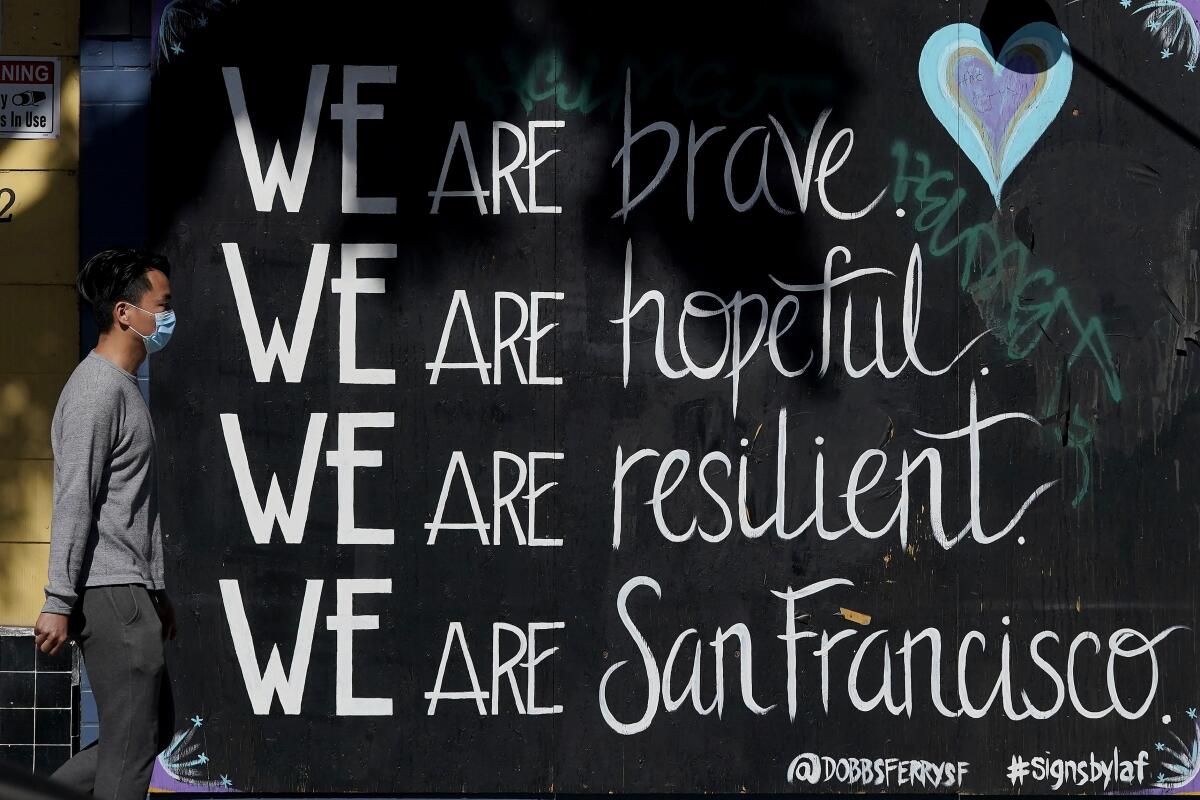
Now, “they’re absolutely in a surge,” said Dr. Monica Gandhi, an infectious diseases physician and professor of medicine at UC San Francisco. “We are going to have to think in the long haul, until we get to enough of the population being immunized.”
California is not necessarily destined for a new wave of coronavirus infections, said Kim-Farley, the UCLA epidemiologist, if residents avoid pandemic fatigue and complacency.
“It’s not so much of an issue of destiny as it is of free will,” Kim-Farley said. “If we adhere to these practices of social distancing, mask use, I think that we can follow and continue a downward trajectory.”
Times staff writers Luke Money and Hugo Martin and San Diego Union-Tribune writers Paul Sisson and Morgan Cook contributed to this report.
More to Read
Sign up for Essential California
The most important California stories and recommendations in your inbox every morning.
You may occasionally receive promotional content from the Los Angeles Times.
